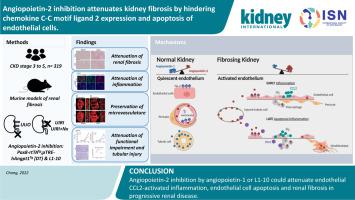Kidney International ( IF 19.6 ) Pub Date : 2022-08-04 , DOI: 10.1016/j.kint.2022.06.026 Fan-Chi Chang , Chia-Hao Liu , An-Jie Luo , Thomas Tao-Min Huang , Ming-Hsuan Tsai , Yu-Jhen Chen , Chun-Fu Lai , Chih-Kang Chiang , Tzu-Hung Lin , Wen-Chih Chiang , Yung-Ming Chen , Tzong-Shinn Chu , Shuei-Liong Lin

|
Plasma levels of angiopoietin-2 are increased in patients with chronic kidney disease (CKD). Moreover, mouse models of progressive kidney disease also demonstrate increased angiopoietin-2 in both plasmas and kidneys. The role of dysregulated angiopoietins in the progression of kidney disease has not been thoroughly investigated. Here, we found in a cohort of 319 patients with CKD that plasma angiopoietin-2 and angiopoietin-2/angiopoietin-1 ratios were positively associated with the development of kidney failure. In mice with progressive kidney disease induced by either ureteral obstruction or ischemia-reperfusion injury, overexpression of human angiopoietin-1 in the kidney tubules not only reduced macrophage infiltration in the initial stage post-injury but also attenuated endothelial cell apoptosis, microvascular rarefaction, and fibrosis in the advanced disease stage. Notably, angiopoietin-1 attenuated chemokine C-C motif ligand 2 (CCL2) expression in the endothelial cells of the fibrosing kidneys, and these protective effects led to attenuation of functional impairment. Mechanistically, angiopoietin-1 reduced CCL2-activated macrophage migration and protected endothelial cells against cell apoptosis induced by angiopoietin-2 and Wnt ligands. Based on this, we applied L1-10, an angiopoietin-2 inhibitor, to the mouse models of progressive kidney disease and found inhibitory effects on macrophage infiltration, microvascular rarefaction, and fibrosis. Thus, we defined the detrimental impact of increased angiopoietin-2 on kidney survival of patients with CKD which appears highlighted by angiopoietin-2 induced endothelial CCL2-activated macrophage infiltration and endothelial cell apoptosis in their kidneys undergoing fibrosis.
中文翻译:

血管生成素-2抑制通过阻碍趋化因子CC基序配体2表达和内皮细胞凋亡来减轻肾纤维化
慢性肾病 (CKD) 患者的血浆血管生成素 2 水平升高。此外,进行性肾病的小鼠模型也显示血浆和肾脏中血管生成素 2 的增加。尚未彻底研究失调的血管生成素在肾脏疾病进展中的作用。在这里,我们在 319 名 CKD 患者的队列中发现,血浆 angiopoietin-2 和 angiopoietin-2/angiopoietin-1 的比率与肾衰竭的发展呈正相关。在输尿管梗阻或缺血再灌注损伤引起的进行性肾病小鼠中,人血管生成素-1 在肾小管中的过表达不仅减少了损伤后初始阶段的巨噬细胞浸润,而且减弱了内皮细胞凋亡、微血管稀疏、和晚期疾病阶段的纤维化。值得注意的是,血管生成素-1 减弱了纤维化肾脏内皮细胞中趋化因子 CC 基序配体 2 (CCL2) 的表达,这些保护作用导致功能障碍的减弱。从机制上讲,血管生成素-1 减少了 CCL2 激活的巨噬细胞迁移并保护内皮细胞免受血管生成素-2 和 Wnt 配体诱导的细胞凋亡。基于此,我们将血管生成素 2 抑制剂 L1-10 应用于进行性肾病的小鼠模型,发现对巨噬细胞浸润、微血管稀疏和纤维化的抑制作用。因此,



























 京公网安备 11010802027423号
京公网安备 11010802027423号